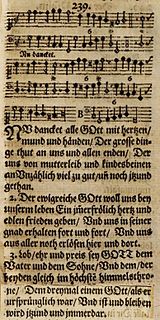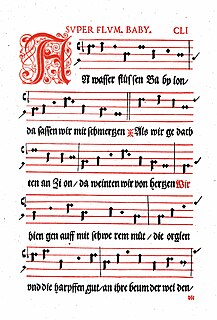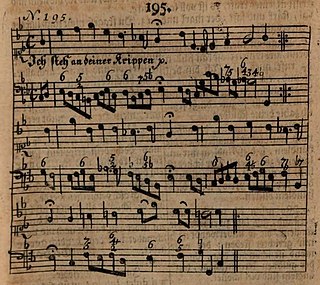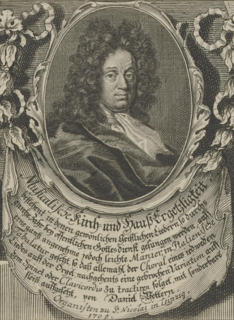
Schemellis Gesangbuch (Schemelli's hymnal) is the common name of a collection of sacred songs titled Musicalisches Gesang-Buch (Musical song book) published in Leipzig in 1736 by Georg Christian Schemelli, to which Johann Sebastian Bach contributed.

Schemellis Gesangbuch (Schemelli's hymnal) is the common name of a collection of sacred songs titled Musicalisches Gesang-Buch (Musical song book) published in Leipzig in 1736 by Georg Christian Schemelli, to which Johann Sebastian Bach contributed.
In 1736, Georg Christian Schemelli Musicalisches Gesang-Buch in Leipzig, a collection of 954 sacred songs. [1] The full title reads "Musicalisches Gesang-Buch, Darinnen 954 geistreiche, sowohl alte als neue Lieder und Arien, mit wohlgesetzten Melodien, in Discant und Baß, befindlich sind: Vornehmlich denen Evangelischen Gemeinen im Stifte Naumburg-Zeitz gewidmet" (Musical song book, with 954 spirited, both old as new songs and arias, with well-composed melodies in soprano and bass, in it: mostly dedicated to the Protestant parishioners in the Stift Naumburg-Zeitz). The texts were written in the tradition of pietism, and were probably intended for private contemplation. Only 69 of the songs come with music, a melody and a bass line. [2] Many melodies resemble simple arias. [1] [3]
Johann Sebastian Bach contributed to the collection, but musicologists debate to what extent. Schemelli's son Christian Friedrich was a student of the Thomasschule from 1733 to 1735, and later studied at the Leipzig University, which explains the contact. In the Bach-Werke-Verzeichnis (BWV) of Bach's works, numbers 439 to 507 list songs from the collection, but his authorship is certain only for three of them, "Dir, dir Jehovah, will ich singen", BWV 452, "Komm, süßer Tod", BWV 478, and "Vergiss mein nicht, vergiss mein nicht", BWV 505. Bach probably wrote the bass lines for the others, and possibly modified some of the melodies. [3]

"Now thank we all our God" is a popular Christian hymn translated from the German "Nun danket alle Gott", written c. 1636 by Protestant minister Martin Rinkart. Its hymn tune, Zahn No. 5142, was published by Johann Crüger in the late 1640s.
"Warum betrübst du dich, mein Herz" is a Lutheran hymn. According to some sources, both hymn writer and composer are anonymous. The melody, Zahn No. 1689a, appeared on broadsides from the mid-16th century in Nürnberg, one of them dated 1561. For a while the tune had been attributed to Hans Sachs.

Gottfried Vopelius, was a German Lutheran academic and hymn-writer, mainly active in Leipzig. He was born in Herwigsdorf, now a district of Rosenbach, Oberlausitz, and died in Leipzig at the age of 70.

"Erhalt uns, Herr, bei deinem Wort" is a Lutheran hymn by Martin Luther with additional stanzas by Justus Jonas, first published in 1542. It was used in several musical settings, including the chorale cantata by Johann Sebastian Bach, Erhalt uns, Herr, bei deinem Wort, BWV 126.

"Heut triumphieret Gottes Sohn" is a Lutheran hymn for Easter. Kaspar Stolzhagen published the hymn in 1592, and its setting by Bartholomäus Gesius was published in 1601. The hymn was adopted in several hymnals, including the Evangelisches Gesangbuch. Composers such as Johann Sebastian Bach based compositions on its hymn tune.
"Warum sollt ich mich denn grämen" is a Lutheran hymn with a text by Paul Gerhardt written in 1653. It was first published that same year in the fifth edition of Johann Crüger's hymnal Praxis Pietatis Melica, set to a melody composed by Crüger. In the 1993 Protestant hymnal, Evangelisches Gesangbuch, it appears as number 370 with a melody composed by Johann Georg Ebeling, which was published with the divergent title "Warum sollt ich mich doch grämen" in Pauli Gerhardi Geistliche Andachten in 1666.
"Herzlich tut mich verlangen" is a German hymn, with lyrics written in 1611 by Christoph Knoll, with a melody adapted from a secular song by Hans Leo Hassler. It is a prayer for a blessed death, beginning "Herzlich tut mich verlangen nach einem sel'gen End". Its hymn tune, Zahn No. 5385a, was later also used for Paul Gerhardt's "Befiehl du deine Wege" and "O Haupt voll Blut und Wunden".

"Schmücke dich, o liebe Seele" is a Lutheran hymn in German, with lyrics by Johann Franck and a hymn tune by Johann Crüger. It was first published in Crüger's 1649 Geistliche Kirchen-Melodien, and was later adopted in other hymnals, such as the 1653 edition of his Praxis pietatis melica.
"Herr Jesu Christ, du höchstes Gut" is the beginning of two Lutheran hymns. One is a penitential hymn, written in 1588 by Bartholomäus Ringwaldt, who possibly also created the melody. The other is an anonymous communion hymn, probably based on the former, which appeared first in 1713. Johann Sebastian Bach's used the penitential hymn several times, including the chorale cantata Herr Jesu Christ, du höchstes Gut, BWV 113, based on the hymn.

"Nun lasst uns Gott dem Herren" is a Lutheran hymn of 1575 with words by Ludwig Helmbold. It is a song of thanks, with the incipit: "Nun lasst uns Gott dem Herren Dank sagen und ihn ehren". The melody, Zahn No. 159, was published by Nikolaus Selnecker in 1587. The song appears in modern German hymnals, including in the Protestant Evangelisches Gesangbuch as EG 320.

"Fröhlich soll mein Herze springen" is a Christian Christmas hymn by Paul Gerhardt, originally in 15 stanzas in artful metre. It was first published, "Frölich sol mein hertze springen", in 1653 in the fifth edition of the hymnal Praxis Pietatis Melica by Johann Crüger, who also created a melody. Johann Sebastian Bach used it as a chorale in his Christmas Oratorio, with a different melody by Johann Georg Ebeling. The song is part, with twelve stanzas, of the current Protestant hymnal Evangelisches Gesangbuch and other songbooks.

"An Wasserflüssen Babylon" is a Lutheran hymn by Wolfgang Dachstein, which was first published in Strasbourg in 1525. The text of the hymn is a paraphrase of Psalm 137. Its singing tune, which is the best known part of the hymn and Dachstein's best known melody, was popularised as chorale tune of Paul Gerhardt's 17th-century Passion hymn "Ein Lämmlein geht und trägt die Schuld". With this hymn text, Dachstein's tune is included in the Protestant hymnal Evangelisches Gesangbuch.

"Die güldne Sonne voll Freud und Wonne" is a Lutheran hymn by Paul Gerhardt. It is a morning hymn which was first published in 1666, with a four-part setting by Johann Georg Ebeling. Gerhardt created an unusual hymn metre for its 12 stanzas.
"Auf meinen lieben Gott" is a Lutheran hymn from the 17th century. Several hymns are sung to the same hymn tune, including "Wo soll ich fliehen hin", and it was set in compositions. The hymn was translated into English as "In God, My Faithful God". It is part of modern hymnals and songbooks.

"Ich steh an deiner Krippen hier" is a German Christmas hymn, with lyrics by Paul Gerhardt which were first published in 1653. It was then sung with an older melody by Martin Luther, but a melody which was likely created by Johann Sebastian Bach for Schemellis Gesangbuch of 1736 is now part of current Protestant and Catholic hymnals.

Georg Christian Schemelli was a German Protestant church musician. He is known for the publication Musicalisches Gesang-Buch, a collection of sacred songs to which Johann Sebastian Bach contributed.

"Liebster Gott, wann werd ich sterben" is a Lutheran hymn which Caspar Neumann, an evangelical theologian from Breslau, wrote around 1690. The topic of the hymn, which has five stanzas of eight lines, is a reflection on death. An elaborate analysis of the hymn's content was published in 1749. A few text variants of the hymn originated in the 18th century. Neumann's text is usually sung to the hymn tune of "Freu dich sehr o meine Seele".